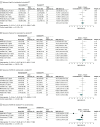Type, Timing, Frequency, and Durability of Outcome of Physical Therapy for Parkinson Disease: A Systematic Review and Meta-Analysis
- PMID: 37477916
- PMCID: PMC10362470
- DOI: 10.1001/jamanetworkopen.2023.24860
Type, Timing, Frequency, and Durability of Outcome of Physical Therapy for Parkinson Disease: A Systematic Review and Meta-Analysis
Abstract
Importance: Parkinson disease (PD) is a neurodegenerative syndrome affecting approximately 1% of the population older than 60 years, and a major goal of treatment is preservation of physical function through physical therapy (PT). Although PT outcomes for PD are well documented, aggregate information on the parameters of PT are needed to guide implementation.
Objective: To evaluate current evidence on the types, timing, frequency, duration, and outcomes of PT regimens applied for PD.
Data sources: PubMed, Embase, Medline, and the Web of Science Core Collection were searched for articles published from January 1, 2000, to August 10, 2022. Search terms included terms related to Parkinson disease, PT interventions, and PT-related outcomes.
Study selection: Included studies were peer-reviewed randomized clinical trials available in English of any PT intervention for patients with PD that included PT-related outcomes. The Preferred Reporting Items for Systematic Reviews and Meta-analyses reporting guideline was followed.
Data extraction and synthesis: Two reviewers extracted data and assessed quality using the Cochrane Risk of Bias Tool. Data were analyzed using a random-effects model.
Main outcomes and measures: A meta-analysis compared outcomes of nonstandard PT vs standard PT and standard PT vs no intervention for Unified Parkinson's Disease Rating Scale (UPDRS) score and measures of gait and balance.
Results: A total of 46 trials with 3905 patients were included (range of mean ages, 61-77 years). Ten trials (22%) compared 2 types of nonstandard PT interventions; 26 (57%), nonstandard PT vs standard PT; and 10 (22%), PT vs no intervention. The most common nonconventional PT intervention was aquatic physiotherapy (5 trials [11%]). Durations of PT regimen ranged from 2 to 12 weeks in 39 trials (85%), and PT was most commonly performed with frequencies of either twice or 3 times weekly (27 [59%]). In most trials (39 [85%]), PT session length ranged from 30 to 60 minutes. Across trials, PT outcomes were reported for gait (14 trials [30%]), balance (10 [22%]), quality of life (3 [9%]), and cognition (1 [2%]). Approximately half of the trials (22 [48%]) documented durability of some level of benefit after completion of the prescribed regimen. Meta-analysis showed no significant difference for PT vs no intervention in UPDRS scores (standardized mean difference [SMD], -1.09; 95% CI, -2.50 to 0.33) or for nonstandard PT vs standard PT in measures of gait (SMD, 0.03; 95% CI, -0.53 to 0.59), balance (SMD, 0.54; 95% CI, -0.03 to 1.12), and UPDRS score (SMD, -0.49; 95% CI, -1.04 to 0.06). Meta-analytic regression of moderators revealed no significant differences in outcomes by frequency of PT per week (SMD, 0.17; 95% CI, -0.03 to 0.36).
Conclusions and relevance: The findings suggest that although a wide range of types and regimens of PT for PD have been tested, comparative effectiveness of different models of care and implementation strategies as well as long-term durability of their outcomes remain undetermined.
Conflict of interest statement
Figures


References
Publication types
MeSH terms
Grants and funding
LinkOut - more resources
Full Text Sources
Medical

